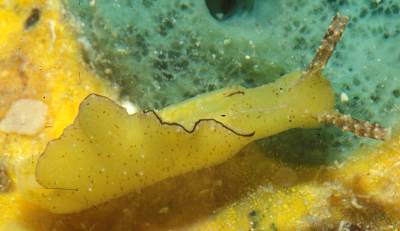
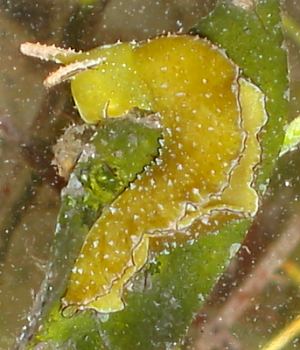
Elysia subornata
Verrill, 1901
Order: SACOGLOSSA
Superfamily: ELYSIOIDEA
Family: Elysiidae
DISTRIBUTION
West Atlantic [Florida (the Keys), Carribean, Brazil]
PHOTO
Upper: Lark Cay, Belize. Photo: Jeff Hamann
Lower: Titusville, Florida, USA. On Caulerpa prolifera. Photo: Christian Glardon
According to Clark (1984) this species is highly variable in colour, ranging from 'yellow green, to dusky olive, to reddish, usually with brownish to black parapodial margins (pale or absent in some specimens)'. The parapodial margin is thickened and whitish, probably due to large glands along the edge. The parapodia are minutely papillose, and often have white spots, sometimes with black rings. The rhinophores are papillose, and have bands of white, grey and or brown. Sometimes the white on the rhinophores and a median white line on the 'neck' form Y shape.
The renopericardial lump is characteristically extremely elongate. From the swollen anterior heart region just inside the parapodia, there is a broad elongation running down the midline, almost to the posterior end of the body. Small lateral vessels branch off this central elongation, all along its length. Grows to 50mm, making it one of the largest west Atlantic sacoglossan. Clark considers Elysia cauze Marcus & Marcus, 1957, from Brazil, to be a synonym. It is one of a number of west Atlantic species with a black parapodial margin. Clark considers the elongate pericardial hump to be an important external distinguishing character.
References.
• Clark, K.B. (1984) New records and synonymies of Bermuda opisthobranchs (Gastropoda). The Nautilus, 98(2): 85-97.
• Redfern. C., 2001. Bahamian Seashells: a Thousand Species from Abaco, Bahamas.
See separate page for full Reference List
Authorship detailsRudman, W.B., 2002 (October 16) Elysia subornata Verrill, 1901. [In] Sea Slug Forum. Australian Museum, Sydney. Available from http://www.seaslugforum.net/find/elyssubo
Related messages
Elysia subornata from Southern Bahamas
February 23, 2004
From: Marina Poddubetskaia
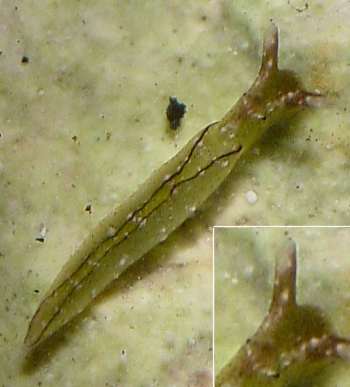
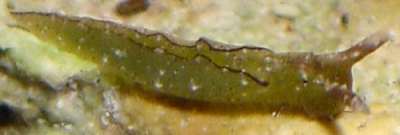
Dear Bill,
When we snorkelled with Anne DuPont in Exuma, we've found many sacoglossan including this Elysia subornata. Please, could you confirm this ID ?
It's strange, but I found this guy on a 'brush alga' (sorry, I don't know its scientific name) which is the main food of Elysia papillosa in this area (if my ID is right). In fact, I took a look at many of this algae and most of the time I saw Elysia papillosa on it. So, it was a surprise to see this specimen here too. Maybe, it's just a coincidence ?
Date: February 05, 2004
Location: Great Exuma, Bahamas, Western Atlantic
Site: Stocking Island, Hole n°0
Depth: 1m
Size: 6-7mm
Photos: Marina Poddubetskaia - Nembro website
Cordially,
Marina.
nembro@nembro.info
Poddubetskaia, M. , 2004 (Feb 23) Elysia subornata from Southern Bahamas. [Message in] Sea Slug Forum. Australian Museum, Sydney. Available from http://www.seaslugforum.net/find/12267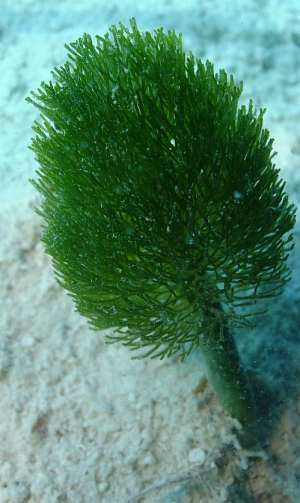
Thanks Marina,
Your 'brush algae' is a species of Penicillus,most probably Penicillus dumetosus. Hopefully an expert on Caribbean algae can help with a species identification. I think I will build up a few pages on common sacoglossan food algae as a guide to those looking for these animals.
Checking the literature, Elysia papillosa is the only species considered to prefer Penicillus as food (Clark, 1987), while E. subornatus is reported to feed on a number of species of Caulerpa, [C. racemosa, C. verticillata, C. paspaloides] (Clark, 1987, Redfern, 2001). So it's possible your animal just took a wrong turn and ended on the Penicillus.
Concerning your identification of this animal. I am sure you are right, although we can wait for confirmation from those with local knowledge. This species is said to be quite variable in colour, the yellow form, which predoinates on the Forum at present, is considered a juvenile stage.
• Clark, K.B., DeFreese, D. (1987) Population ecology of Caribbean ascoglossa (Mollusca: Opisthobranchia): a study of specialized algal herbivores. American Malacological Bulletin, 5(2): 259-280.
• Redfern. C., 2001. Bahamian Seashells: a Thousand Species from Abaco, Bahamas.
Best wishes
Bill Rudman
Re: Elysia subornata and egg masses
June 14, 2003
From: Kathe R. Jensen
Dear Bill,
The yellow "string" in the Elysia subornata egg mass is the extracapsular yolk. The egg capsules and embryos are unfortunately out of focus. The same type of egg mass is found in at least 3 Caribbean species of Elysia - E. tuca, E. subornata & E. pratensis, and possibly also in one or two undescribed species (from Caulerpa).
Best regards,
Kathe
krjensen@zmuc.ku.dk
Jensen, K.R., 2003 (Jun 14) Re: Elysia subornata and egg masses. [Message in] Sea Slug Forum. Australian Museum, Sydney. Available from http://www.seaslugforum.net/find/10219Thanks Kathe,
It is a very strange arrangement - it would be very interesting to know if the larvae actually derive any nourishment from this 'yolk'. Not only is it outside their individual development capsule, but outside the mucus egg ribbon which supposedly protects them from adverse environmental dangers.
Best wishes,
Bill Rudman
Elysia subornata and egg masses
June 13, 2003
From: Christian Glardon

Dear Bill,
This Elysia subornata and egg mass were found at Titusville in Florida, USA. On Caulerpa prolifera.
Christian Glardon
sonatedesheimes@mac.com
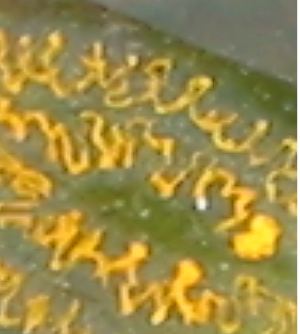
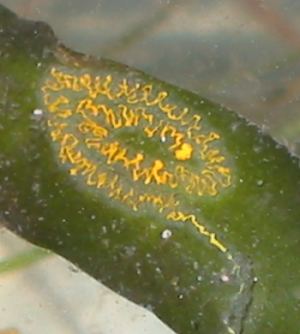
Thanks Christian,
The egg ribbon is rather puzzling. I don't know if the yellow 'smear' is an example of extra-capsular yolk, or whether this is just an abnormal egg-laying. In the close-up [lower left] there are very few signs of eggs in the underlying mucus layer. I would suspect this is a failed egg-laying but looking at the photos of the egg ribbon of another Caribbean Elysia, Elysia pratensis, suggests that more than one Elysia from the Caribbean has this peculiar arrangement of yolk.
Best wishes
Bill Rudman
Re: Elysia subornata from Florida
May 24, 2003
From: Kathe R. Jensen
Dear Linda and Bill,
Concerning Linda's photo I agree that this it is most likely Elysia subornata. There is also an undescribed Elysia from central Florida with "fuzzy" parapodial margins and a blue patch on the neck, but I do not see any signs of the blue patch in this one.
Cheers,
Kathe
krjensen@zmuc.ku.dk
Jensen, K.R., 2003 (May 24) Re: Elysia subornata from Florida. [Message in] Sea Slug Forum. Australian Museum, Sydney. Available from http://www.seaslugforum.net/find/10035Thanks Kathe,
Bill Rudman
Elysia subornata from Florida
May 23, 2003
From: Linda Ianniello
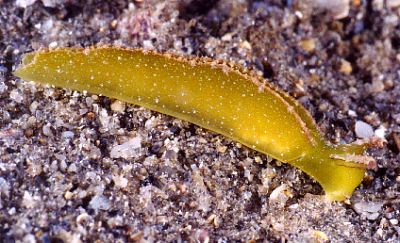
Dr. Bill,
Jeff Hutchinson, who found the Cerberilla last week, found this Elysia on a night dive - May 3, 2003 in West Palm Beach, Florida and I took this photo. It was just out in the sand, at a depth of about 15 feet. I believe it is an Elysia, but can't find anything quite like it with the "fuzzy" rhinophores and edge of the "folds". Most Elysia have a very distinctly-colored band on the edge of the fold ... Can you identify it?
Thanks and regards,
Linda I.
lindai@us.ibm.com
Ianniello, L., 2003 (May 23) Elysia subornata from Florida. [Message in] Sea Slug Forum. Australian Museum, Sydney. Available from http://www.seaslugforum.net/find/9869Dear Linda,
Although there does not seem to be much sign of a dark brown edge to the parapodia, I would guess this is Elysia subornata. It could I suppose be a yellowish form of E. papillosa but the parapodia do not show any folding along the edges. Perhaps Kathe Jensen or someone else who has worked with these animals can help us.
Best wishes,
Bill Rudman
Distribution of Elysia subornata
February 9, 2003
From: Thierry Thibaut
Dear Bill,
There is a small mistake concerning the distribution of Elysia subornata Verrill 1901. This species does not live in the Mediterranean Sea. The distribution is :Florida (the Keys), the Carribean, Brazil. This species is actually studied as a potential control agent against the introduced and invasive Caulerpa in the Mediterranean (Caulerpa taxifolia and Caulerpa racemosa var. occidentalis) but all the experiments are done far from the Sea and no release has been done into the Sea.
Congratulations for your website it's really excellent.
Thierry Thibaut
thibaut@ceab.csic.es
Dear Thierry,
I have followed your research work over the last few years with great interest, so I should have noticed I had the distribution incorrect myself. Thanks very much for letting me know. I am always grateful for being made aware of any errors.
Best wishes,
Bill Rudman
Elysia papillosa from Belize
October 21, 2002
From: David Behrens
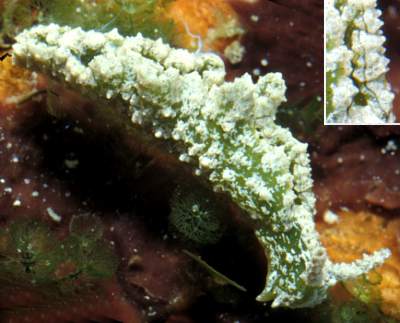
Note added 4 March 2004: According to Kathe Jensen [see message #10846] this is Elysia subornata.
Bill:
While enjoying your fantastic inventory of sacoglossids from around the world, I thought you would like to add two of Jeff Hamann's great photos to the Fact Sheet for Elysia papillosa Verrill, 1901. Jeff and I collected both of these specimens at Ranguana Cay, Belize, Central America.
Dave Behrens
dave@seahallengers.com
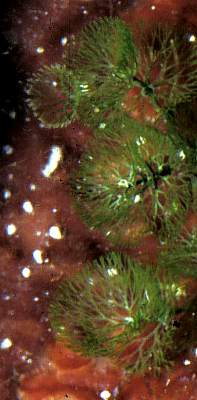
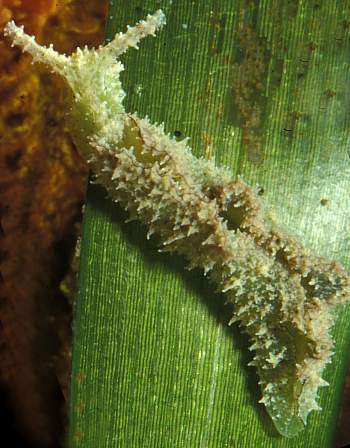
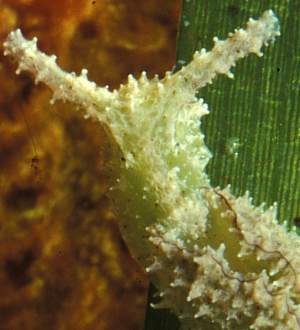
Thanks Dave,
This is a nice addition to the Forum. Jeff's photos certainly show the external features that Kerry Clark considered characteristic of this species, including the papillae and the dark brown line along the parapodial edge in larger animals. I am sure we will only make sense of this group of animals when we have a better idea of their colour variation. There is not much point in knowing the anatomy of decolourised carcases if we can't tie the anatomy to living shapes and colour patterns.
By the way, is the algae I have enlarged from Jeff's photo Penicillus?
Best wishes,
Bill Rudman
Elysia subornata from Belize
October 21, 2002
From: Dave Behrens

Hi Bill:
Another Elysia from Belize, photographed by Jeff Hamann. We identified this as Elysia subornata, which I believe agrees with Redfern (2002). This specimen has a damaged left mantle, but never the less looks quite happy. I collected the specimen on a red filamentous algae in the mangroves at Lark Cay.
Dave Behrens
dave@seachallengers.com
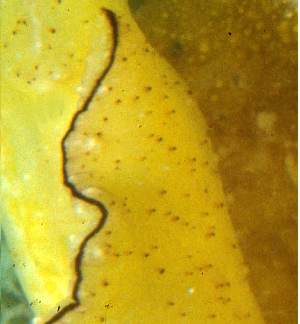
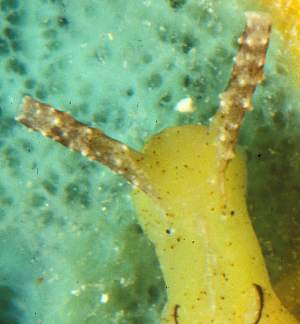
Dear Dave,
I would agree this is most probably E. subornata. Kathe should be able to confirm this for us.
Best wishes,
Bill Rudman
